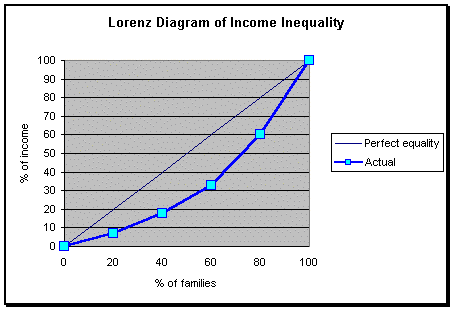CHAPTER 13:
INCOME REDISTRIBUTION
LEARNING OBJECTIVE The purpose of this topic is to establish that extensive income inequality is present in our society. A trade-off is studied between the need to remedy hardship of the destitute while still preserving the incentive to work hard for higher income. The major income maintenance programs are outlined (social security, welfare and unemployment benefits), and problems related to them are mentioned.
PERSONAL INCOME DISTRIBUTION The personal income distribution shows the proportion of population by income level bracket. It reveals that a small number of families receive very high incomes.
| The wealthiest 20% of the families in the United States receives 41% of the total income.
The next 20% of families receives 24% of the income. The middle income 20% of families receives 18%. The 20% of families below middle income receives 12%. The lowest income 20% of families receives only 5% |
INCOME INEQUALITY The presence of a wide disparity in income can be observed in the personal income distribution. The cumulative income distribution is represented in the Lorenz curve. Income inequality does not necessarily imply inequity.
LORENZ CURVE The Lorenz curve shows the cumulative proportion of income received by cumulative proportions of population (broken down in quintiles, i.e. 20%). The diagonal would represent perfect equality in income. The extent to which the Lorenz curve is away from the diagonal shows the extent of income inequality. Since 1929, the Lorenz curve has shifted somewhat closer to the diagonal.

| The top 20% of the population receives 41% of the income. This is much higher than the 20% that it would receive if the income distribution were equal for all. But, it is also much less that what the same top 20% of the population received 50 years ago, which was 54%. |
LORENZ CURVE CRITICISM The Lorenz curve has been criticized because it does not take into consideration transfer payments and income taxes. Both of these would reduce income inequality. In addition, the lifetime income pattern (being higher in mid-adult age than early or late in life) also puts into question the usefulness of the analysis.
| The marginal tax rate on the highest income was 70% and 50% until very recently. The highest income families received much less than what gross income numbers show. Likewise for the lower income families, payments of unemployment benefits and welfare programs need to be added to the gross income numbers. |
INCOME INEQUALITY CRITICISM Income inequality can be explained by the lifetime pattern of income of all individuals, which is highly uneven. Income inequality can be further explained by several reasons such as the acquisition of skills. Moreover, income inequality can be justified by the need to motivate employees.
LIFETIME INCOME Income of all individuals follows a similar pattern of steady increase throughout the adult life, then rapidly decreases in the last years of employment. This observation puts into question the extent of income inequality shown by the Lorenz curve.
INCOME INEQUALITY SOURCES Income inequality can be attributed to – skills, – level of education, – willingness to accept uncertainty, – property ownership (about 70% owned by 10% of families), – market imperfections.
CASE FOR INCOME REDISTRIBUTION The argument in favor of income redistribution is based on the fact that the marginal utility forgone by a high income individual is far less than the marginal utility gain of the low income recipient. Thus, total marginal utility would increase with income redistribution. Another line of reasoning looks at income redistribution programs as a form of insurance in case a high income individual falls on hard times.
CASE AGAINST INCOME REDISTRIBUTION Income redistribution programs are disincentives for those who have to contribute. The income redistribution programs are also disincentives to work for the recipients. The danger exists that as a result of the combination of these disincentives the total output of the country would decrease.
DISCRIMINATION ECONOMIC EFFECT All forms of discrimination lead to underutilization of productive resources. The economy thus fails to achieve efficiency and full potential output. Furthermore, the income not received also contributes to a shortfall in economic activity.
| The median income of nonwhite families is 66% of median income of white families, or about one third lower. Although this disparity reveals discrimination in salaries, the disparity is less than what it was 30 years ago when nonwhite families income was but 54% of white families income. |
INCOME MAINTENANCE PROGRAMS The major income maintenance programs are – social security: Old Age, Survivors, and Disability Health Insurance, and Medicare; – welfare: Aid to Families with Dependent Children, and Supplemental Security Income, and Medicaid; – unemployment compensation.
INCOME MAINTENANCE PROGRAMS Social security has ceased to be a self insurance type program since the early 1970’s when the funds ran out. Contribution rates have increased considerably since its creation (from 3% to 15%), but further increases may be necessary as the baby boom generation retires. However, American social security regained a surplus in the late 1990 as a result of large contribution during these years of American prosperity.
INCOME MAINTENANCE PROGRAMS Welfare programs suffer from – duplication of wasteful administration, – inequities (between individuals and regions), – the program being a trap for the recipients since it is a disincentive to work or return to family life. In spite of these problems, the program cannot be dismantled because of the potential hardship.
NEGATIVE INCOME TAX A negative income tax has been proposed as a substitute for the administratively wasteful income maintenance programs. It would provide for a payment of a negative tax to individuals below a certain income.
U.S. BUREAU OF THE CENSUS The U.S. Bureau of the Census provides information on how personal income is distributed among income classes, the percentage of families in a income class, and the percentage of total income received by all the families in a income class. It takes into consideration nominal income and cash transfer payments. It does not subtract social security taxes or income taxes. Census data is often criticized because the income concept is considered too narrow and the accounting period too short.
BROADER INCOME CONCEPT Data provided by the U.S. Bureau of the Census is frequently criticized for defining the income concept too narrowly. Broader income concepts take the following into consideration:
1) payroll taxes,
2) personal income taxes,
3) in-kind transfers, and
4) capital gains.
After these adjustments are made to census data, greater income equality will usually exist.
GOVERNMENT ROLE Income redistribution is an important function of the government. It is accomplished through taxes and transfer payments. Since the tax system of the United States is not highly progressive (after 1990), transfer payments are a more effective means of income redistribution. Taxes and transfer payments shift the Lorenz curve upward and to the left, reducing the area of income inequality.
POVERTY A precise definition for poverty does not exist. A household that cannot meet its basic needs is generally considered to be in poverty. The primary factors the government uses in deter- mining poverty is income, transfer payments, property owned, and family size. Approximately 15% of the population in the United States is in poverty. Poverty exists in all areas of the nation and in all population groups. Minorities have higher poverty rates than whites.
POVERTY The poverty rate declined substantially in the 1960s, but recently it has begun to rise again. Poverty is not too readily visible due to the following factors:
1) the poor lack political power,
2) the poor tend to be isolated in urban and rural areas, and
3) a sizable portion of the population drift in and out of poverty.
The higher proportion of minorities in poverty is often attributed to discrimination.
Poverty can be reduced by eliminating discrimination.

[…] MIC ECON Lec 13 – Income Redistribution […]
LikeLike